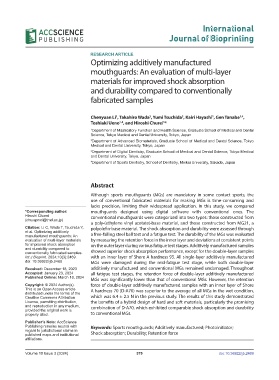Page 387 - IJB-10-3
P. 387
International
Journal of Bioprinting
RESEARCH ARTICLE
Optimizing additively manufactured
mouthguards: An evaluation of multi-layer
materials for improved shock absorption
and durability compared to conventionally
fabricated samples
Chenyuan Li , Takahiro Wada , Yumi Tsuchida , Kairi Hayashi , Gen Tanabe ,
2
1
3
1
1,4
Toshiaki Ueno , and Hiroshi Churei *
1
1,4
1 Department of Masticatory Function and Health Science, Graduate School of Medical and Dental
Science, Tokyo Medical and Dental University, Tokyo, Japan
2 Department of Advanced Biomaterials, Graduate School of Medical and Dental Science, Tokyo
Medical and Dental University, Tokyo, Japan
3
Department of Digital Dentistry, Graduate School of Medical and Dental Science, Tokyo Medical
and Dental University, Tokyo, Japan
4 Department of Sports Dentistry, School of Dentistry, Meikai University, Sakado, Japan
Abstract
Although sports mouthguards (MGs) are mandatory in some contact sports, the
use of conventional fabricated materials for making MGs is time-consuming and
lacks precision, limiting their widespread application. In this study, we compared
*Corresponding author: mouthguards designed using digital software with conventional ones. The
Hiroshi Churei conventional mouthguards were categorized into two types: those constructed from
(chu.spmd@tmd.ac.jp)
a poly-(ethylene vinyl acetate)-base material, and those constructed from MG21, a
Citation: Li C, Wada T, Tsuchida Y, polyolefin-base material. The shock absorption and durability were assessed through
et al. Optimizing additively
manufactured mouthguards: An a free-falling steel ball test and a fatigue test. The durability of the MGs was evaluated
evaluation of multi-layer materials by measuring the retention force in the inner layer and deviations at consistent points
for improved shock absorption on the outer layer during various fatigue test stages. Additively manufactured samples
and durability compared to
conventionally fabricated samples. showed superior shock absorption performance, except for the double-layer samples
Int J Bioprint. 2024;10(3):2469. with an inner layer of Shore A hardness 95. All single-layer additively manufactured
doi: 10.36922/ijb.2469 MGs were damaged during the mid-fatigue test stage, while both double-layer
Received: December 18, 2023 additively manufactured and conventional MGs remained undamaged. Throughout
Accepted: January 23, 2024 all fatigue test stages, the retention force of double-layer additively manufactured
Published Online: March 18, 2024
MGs was significantly lower than that of conventional MGs. However, the retention
Copyright: © 2024 Author(s). force of double-layer additively manufactured samples with an inner layer of Shore
This is an Open Access article A hardness 70 (D-A70) was superior to the average of all MGs in the wet condition,
distributed under the terms of the
Creative Commons Attribution which was 6.4 ± 2.5 N in the previous study. The results of this study demonstrated
License, permitting distribution, the benefits of a hybrid design of hard and soft materials, particularly the promising
and reproduction in any medium, combination of D-A70, which exhibited comparable shock absorption and durability
provided the original work is
properly cited. to conventional MGs.
Publisher’s Note: AccScience
Publishing remains neutral with Keywords: Sports mouthguards; Additively manufactured; Photoinitiator;
regard to jurisdictional claims in
published maps and institutional Shock absorption; Durability; Retention force
affiliations.
Volume 10 Issue 3 (2024) 379 doi: 10.36922/ijb.2469

